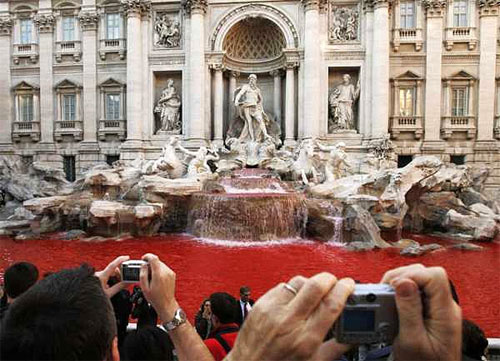In my rhetoric course, I ask students to find and bring in examples of protests. This week, one of my students brought in a news story about a man (Graziano Cecchini) who poured red dye into the Trevi fountain in Italy. 
According to The Guardian , "Police found leaflets near the fountain signed by a rightwing group claiming responsibility for the act. The leaflets said the red paint was a protest at the cost of organising the Rome Film Festival and symbolically referred to the event's red carpet."
The image Cecchini creates is striking - pictures of it abound on the internet in spite of the fact that Italian authorities had the paint and fountain cleaned up in a matter of hours. I find Cecchini's protest to be effective in terms of garnered publicity and awareness, but find that it drops the ball in terms of connecting viewers with his actual issues about the Film Festival. But, as we discussed in class, protests whose aim is first and foremost publicity often aren't necessarily concerned with making specific points but rather raising awareness in a more general kind of way. I'm not sure if I find this to be true most of the time, but it does seem to be the case with Cecchini's particular protest - and it works.
Comments
grafitti
i don't see how people could do that to the trevi fountain. they didn't realize that it means so much more to people. it is truly a godly gift. i think they should've protested city hall or something else but the trevi fountain is so much more than a tourist sight. it's part of my ansestors and my past. public graffitti is not the way to handle money situations.
-my opinion only